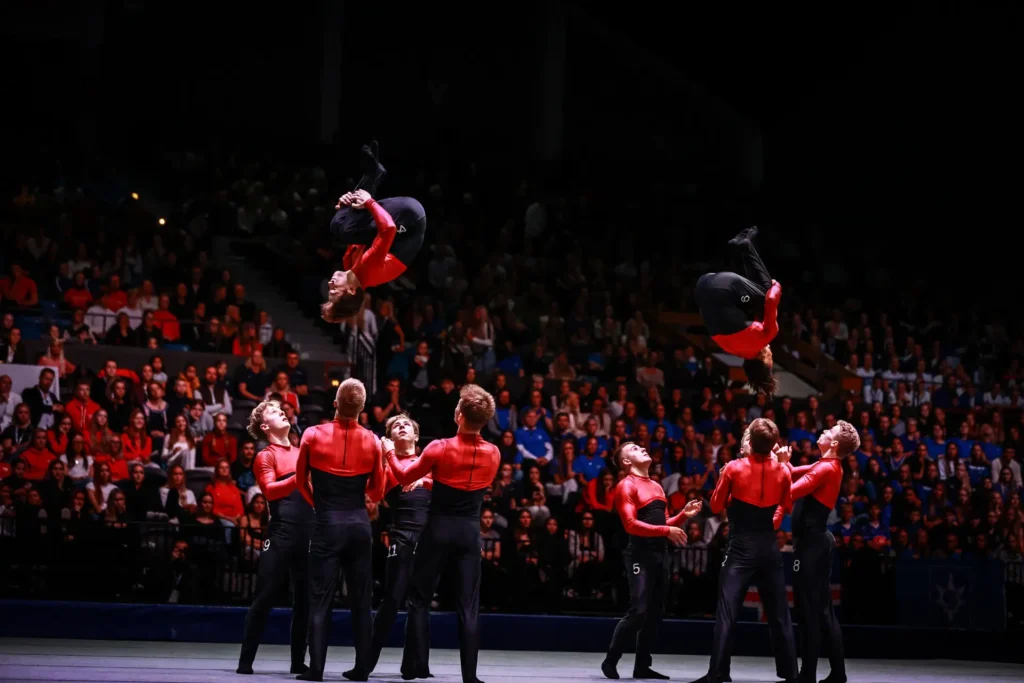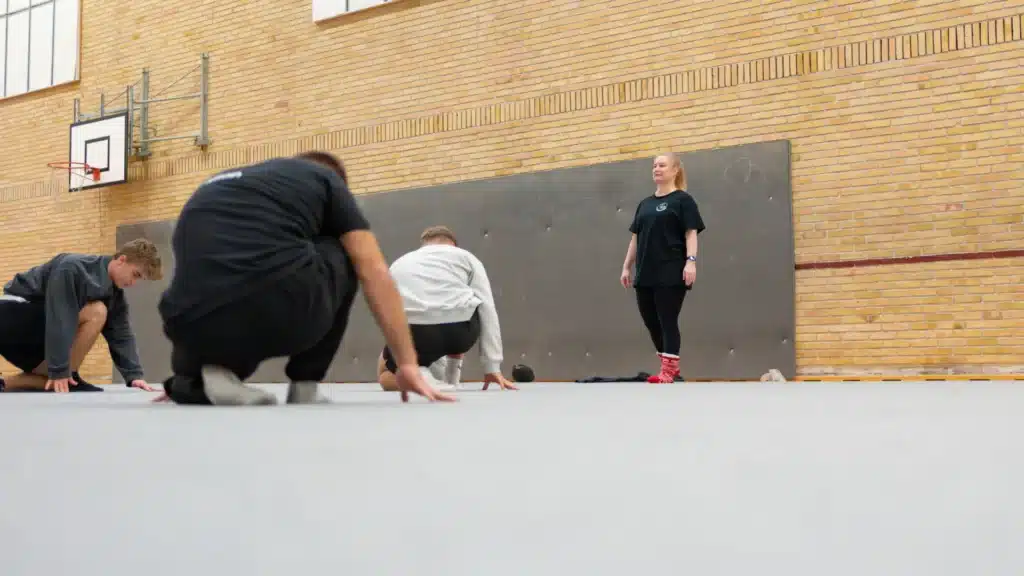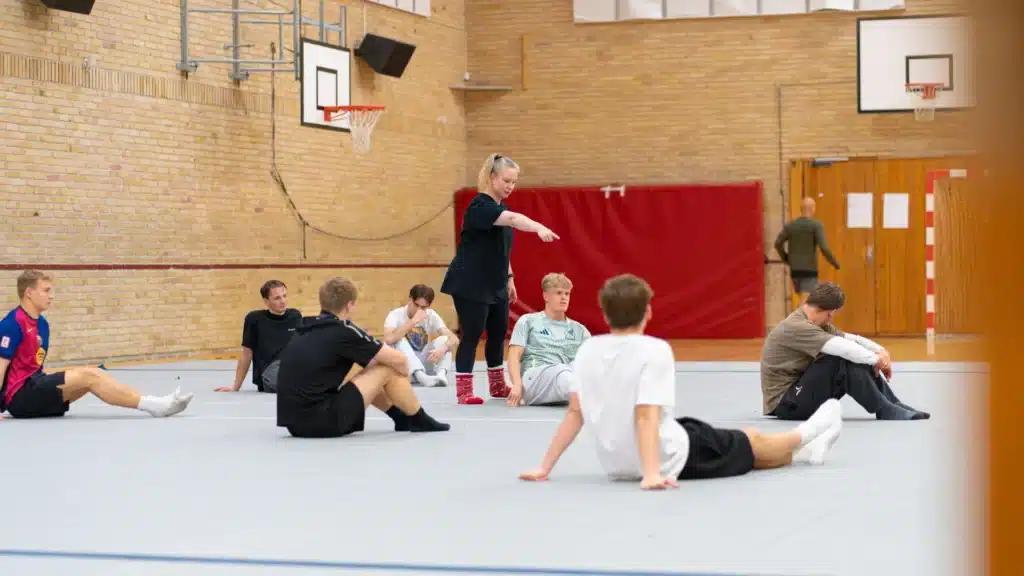One of the things that really motivates me is setting training goals and competition goals for all my teams. I love being part of the gymnasts’ development and seeing how far we can push each individual gymnast this season—or over the next, say, three years!
A training goal might be for all gymnasts on the team to learn how to hold a completely straight handstand (with straight knees, hips, and ankles) when performing it on the floor. The handstand is always a bit tricky during competitions, so it’s good to practice doing it well during training and to be aware of what to focus on to perform a good handstand. It can always go wrong in competition when adrenaline is running through the body, but as long as the gymnasts are practicing and doing their best, I can’t expect more from them.
Another training goal could be for everyone on the team to learn a new element, such as press to handstand. The gymnasts might not include the element in the competition this season, but the goal is for them to learn it during this season. I communicate this to the gymnasts, both so they understand why we’re doing what we’re doing, but also to create shared motivation within the team.
Training goals can be both long-term and short-term. A short-term goal might be that I tell the gymnasts at a training session that everyone must do a free cartwheel, and it doesn’t necessarily have to be on the floor. They are allowed to build a station or path that makes it easier for them to perform the free cartwheel. I might even offer a prize if everyone succeeds during the training session. In my experience, girls’ teams can sometimes be very perfectionistic with everything they do and prefer not to do anything wrong or “ugly.” But this kind of task is usually very well received because it gives them permission not to be perfect.
It could also be that all gymnasts must do three headstands held completely still for 8 counts, and only once that’s achieved may they move on to the next exercise. Or the requirement could be that two gymnasts together must hold five headstands in total. Teamwork and an achievable challenge—what’s not to like?
A competition goal could be that the team stands correctly in all formations or that the moving curved formation is approved. Another competition goal could be getting the C score approved. This requires that the gymnasts understand the specific requirements of the entire C score and that the coach correctly inputs the requirements into the tariff.
A very ambitious goal could be to avoid deductions for lack of dynamics throughout the entire routine—but that takes serious work and is more of an “eternal” goal! The same goes for pointed feet…
I don’t focus on scores for the youngest gymnasts. It makes no sense to focus on a number in a table when it comes to developing young athletes. Here, I focus only on the specific goals we’ve set as a team. For example—did the group element work, did the gymnasts stand correctly in formations, and what do we need to work on for it to be fully successful? I clearly communicate the focus of the competition to the gymnasts so they know what I expect of them. I think it’s unfortunate if scores are the only thing coaches/gymnasts/parents care about. That puts the focus on performance, and we forget what’s most important—gymnastics should be fun, developmental, and challenging in a healthy way. Talent development means maintaining the joy of gymnastics while maturing, developing, and challenging the gymnast so they continue progressing and remain active even as senior athletes. That’s the long-term goal!
Even when gymnasts reach senior level, my main focus is still what went well and what we can improve. The score is a tool I use as a coach to determine where our focus should lie in the coming weeks. If we receive a lot of deductions for flexed feet, then that’s what I’ll spend more time on in upcoming practices. The score can be used to motivate gymnasts to continue working on movement quality and synchronization throughout the floor routine. “What do we need to do to get over 8.0 in the E score?” Then we can talk about what it actually takes—because it’s difficult and requires a lot of hard work.
The E score can vary from competition to competition, because it depends on the judging standard on the day. Additionally, unexpected mistakes in the routine can always happen, so I can’t compare two scores from two different competitions in a season. That’s why I’m also cautious about setting score-related goals for the gymnasts. That doesn’t mean I never use scores as a goal. For example, with senior men, I might aim for the ultimate difficulty score of 10.00 (7.8 the new CoP 2025) points, which is the highest a team can achieve. These senior gymnasts are at the very top level, and they are motivated by achieving scores and breaking records. It’s not enough for them just to stand correctly in a formation or to have the group element succeed. Throughout their careers, they’ve trained and developed continuously, and now, as senior gymnasts, a competition goal might be to deliver under pressure. Here, the goal is for EVERYONE to hold the handstand completely still, for all elements to be approved, and for an E score over 8.5 in the first round. In short—everything needs to be perfect on the day, and we’re aiming for the perfect performance with the elements we’ve chosen. That’s why I can focus on performance and sometimes set goals that are numerical. I would never approach a younger team in the same way.
Are you aware of the goals you have for your team, and do your gymnasts know what you expect from them?
Consider what your goals are and whether they align with your gymnasts’ development for this season, next season, and the one after that.


